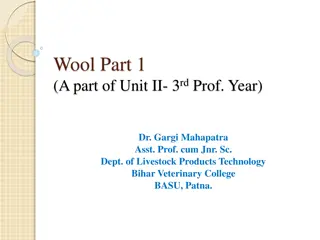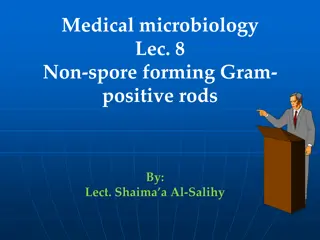Updating ERC Panel Structure for 2024 Calls: Rationale and Main Changes
The European Research Council will revise its panel structure for the 2024 calls to enhance coherence, focus on frontier research, and appreciate interdisciplinarity. The main principles reflect the overarching evaluation policy of the ERC, ensuring a forward-looking approach that evolves with the c
3 views • 12 slides
CAPITAL STRUCTURE
Capital structure refers to the mix of a firm's capitalization, including debt, preference share capital, equity share capital, and retained earnings. Choosing the right components of capital is crucial based on the organization's function and risk level. Different patterns/forms of capital structur
1 views • 6 slides
Lewisham:Proposed structure
The organizational structure in Lewisham outlines key positions such as Executive Lead, Director of System Development, and Director of Adult Integrated Commissioning. Various roles within the structure include Adult Safeguarding Designate, System Development Manager, and Mental Health Assistant Dir
0 views • 6 slides
Evolution and Characteristics of Archegoniates in Plant Kingdom
Archegoniates, believed to have originated from ancestral green algae, exhibit unique characteristics such as heterospory, presence of archegonia for egg production, and multicellular generations with heteromorphic alternation. They adapted to land by developing specialized structures like rhizoids,
0 views • 15 slides
Understanding Rust and Smut Fungi in Basidiomycotina
Basidiomycotina is a diverse group of fungi encompassing classes like Teliomycetes and Hymenomycetes. Rust and smut fungi belong to the class Teliomycetes, characterized by dikaryotic resting spores and unique modes of reproduction. Within the Teliomycetes, the order Uredinales, known as rust fungi,
0 views • 21 slides
Understanding Bacterial Spores: Structure, Formation, and Germination
Bacterial spores, the highly resistant resting stage of bacteria, are formed in unfavorable conditions. This article explores the structure of a spore, the process of sporulation, and germination stages. Learn about the shape and position of spores, as well as sporicidal agents that are effective ag
0 views • 13 slides
Archegoniates: Primitive Plants with Unique Reproductive Structures
Archegoniates are a group of primitive plants believed to have originated from ancestral green algae. They possess distinct reproductive structures such as archegonia, which house the egg cell and give rise to the sporophytic generation. Heterospory in archegoniates leads to the formation of microsp
1 views • 15 slides
Understanding Clostridium perfringens: Morphology, Cultural Characteristics, Toxins, and Diseases
Clostridium perfringens is a Gram-positive spore-forming bacillus found in various environments. It exhibits distinct morphological characteristics, cultural behaviors, and produces different toxins associated with diseases in humans and animals. Understanding its properties is crucial for effective
0 views • 26 slides
Bacterial Staining Techniques Overview
Spore staining, acid-fast staining, and negative staining are essential techniques in microbiology for differentiating bacterial structures based on staining properties. Spore staining highlights spore formers, acid-fast staining differentiates acid-fast bacteria, and negative staining detects capsu
5 views • 6 slides
Overview of Corynebacterium: Characteristics, Infections, and Laboratory Diagnostics
Corynebacterium is a genus of Gram-positive rod-shaped bacteria widely distributed in nature. They are catalase positive, non-spore-forming, non-motile bacteria with unique morphological features. The most notable human infection caused by Corynebacterium is diphtheria, characterized by the formatio
0 views • 25 slides
Methods for Mass Production of AM Inoculants
Techniques for mass production of arbuscular mycorrhizal (AM) inoculants involve in vivo culture on green house plants, spore production with antibiotic treatment, field growth monitoring, and in vitro/axenic culture techniques. Solutions include using living roots, inert substances like vermiculite
1 views • 12 slides
Understanding Bryophyte Marchantia: Botanical Insights
Marchantia, a thalloid bryophyte, exhibits dichotomous branching and a gametophyte-dominant life cycle. It is dioecious with distinct male and female thalli bearing antheridia and archegonia. With around 65 global species, including common ones like M. polymorpha, it thrives in moist, sandy habitats
1 views • 14 slides
Features of an Appropriate Capital Structure and Optimum Capital Structure
While developing a suitable capital structure, the financial manager aims to maximize the long-term market price of equity shares. An appropriate capital structure should focus on maximizing returns to shareholders, minimizing financial insolvency risk, maintaining flexibility, ensuring the company
2 views • 5 slides
Understanding Bacterial Spore Survival and Thermal Death Rates
Survival of bacterial spores during heat processing is crucial for food safety. The concept of Decimal Reduction Time (D value) and Thermal Death Time (TDT) curve help in understanding the thermal destruction of bacteria or spores. The Z value indicates the change in temperature necessary to cause a
6 views • 14 slides
Understanding the Physical Structure of Wool Fiber
Wool is a natural protein fiber with a unique structure composed of a cortex and cuticle, lacking a medulla. Its physical structure includes the cuticle as the outer protective layer, cortex with corticular cells, cell membrane complex, macro-fibrils, matrix, micro-fibrils, and helical coils. The st
1 views • 17 slides
Reproduction in Organisms: Overview and Types
Understanding the concept of reproduction in organisms, this content delves into the different modes of reproduction such as asexual and sexual, with examples and illustrations. It covers the life spans of various organisms and details various methods of asexual reproduction like fission, budding, s
0 views • 23 slides
Thyroid and Parathyroid Glands Histological Structure Overview
This detailed histological study covers the structure and function of the thyroid and parathyroid glands. It includes information on the stroma, parenchyma, follicular cells, parafollicular cells, and the microscopic structure of the parathyroid gland. The article also delves into the functions of v
0 views • 8 slides
Managing Microbiological Quality in Pharmaceutical Environments
The quality of microbiological products is influenced by the pharmaceutical environment materials. Good Manufacturing Practices (GMP) play a crucial role in minimizing contamination risks. Various sources of contamination include the atmosphere, water, persons, raw materials, packaging, buildings, a
0 views • 128 slides
Aromatic Hydrocarbons: Structure, Aromaticity, and Nomenclature
Aromatic hydrocarbons, with benzene as a key example, possess unique properties due to their highly unsaturated structures. The molecular formula of benzene is C6H6, and it exhibits resonance through a planar structure with sp2-hybridized carbons. To be classified as aromatic, a compound must have a
0 views • 19 slides
Understanding Protein Tertiary Structure and Motifs
Protein tertiary structure, essential for enzyme function and protein design, refers to the overall three-dimensional arrangement of amino acid side chains in a protein chain. This structure is specific to each protein sequence, with domains and motifs playing key roles in protein architecture. Prot
0 views • 13 slides
Understanding Different Types of Reproduction in Organisms
Unwanted materials can be passed directly or indirectly, impacting the complexity of systems and bodies. Reproduction methods include sexual and asexual, each with unique processes and characteristics. Asexual reproduction involves division and growth, while sexual reproduction combines hereditary i
1 views • 105 slides
Overview of U.S. Army Force Structure and Unit History Division
This content delves into the lineage, honors, and organizational history of the U.S. Army Force Structure and Unit History Division, highlighting its role in maintaining official unit designations, selecting historic units for reactivation, and supporting force structure planning. It outlines the fu
1 views • 11 slides
Introduction to Histology and Microscopy in Anatomy
Histology is the study of tissue structure and function in animals and plants, focusing on the microscopic structure of cells, tissues, and organs. It helps in understanding the relationship between structure and function, intertwining disciplines like cell biology, pathology, physiology, and bioche
0 views • 5 slides
Exploring Kingdoms Protista and Fungi: Characteristics and Structures
Dive into the world of Protista and Fungi through this interactive review. Discover the unique characteristics of protists, identify different types of protists, and learn about essential structures in protists such as contractile vacuoles. Explore the significance of compounds like fucoxanthin in b
0 views • 27 slides
General Characteristics and Reproduction in Pteridophytes
Majority of living Pteridophytes, including terrestrial, aquatic, xerophytic, and epiphytic species, exhibit unique characteristics in their plant body structure. They possess sporophytic plant bodies with differentiated root, stem, and leaves, showcasing a variety of forms and adaptations. Reproduc
0 views • 21 slides
Impact of Microgravity on Mold Growth on White Bread
This experiment investigates the effect of microgravity on mold growth on white bread. The team of 6th graders from New Explorations into Science, Technology & Mathematics aims to understand mold dust in the air, mold spores reproduction, and the conditions necessary for mold growth. Using an FME ty
0 views • 8 slides
Understanding Dryopteris Fern Life Cycle
Dryopteris, commonly known as wood fern or male fern, is a genus of ferns with around 250 species primarily found in the temperate Northern Hemisphere. These ferns have distinct characteristics like creeping rootstocks, fronds with sori, and triangular-shaped leaves with fiddlehead sprouts. The spor
0 views • 17 slides
Understanding Reproductive Modes: Asexual vs. Sexual
Reproduction can occur through asexual or sexual means, each with its distinct processes and outcomes. Asexual reproduction involves only one parent and produces genetically identical offspring, while sexual reproduction involves the fusion of specialized sex cells from two parents to create genetic
1 views • 46 slides
Overview of Corynebacterium diphtheriae Pathogenesis and Virulence Factors
Corynebacterium diphtheriae is a non-spore forming Gram-positive bacillus responsible for causing diphtheria in humans. This bacterium, particularly C. diphtheriae, is known for producing a potent exotoxin called diphtheria toxin, which blocks protein synthesis and leads to serious complications suc
0 views • 25 slides
Production of Penicillin in Biochemistry and Biotechnology
Penicillin is an antibiotic produced from high-yielding strains of Penicillium chrysogenum. The production process involves maintaining the strains as spore suspensions, inoculation methods, composition of inoculum, production medium requirements, and use of precursors like phenyl acetic acid deriva
0 views • 22 slides
Overview of CLIC Main Linac Accelerating Structure Design
Detailed discussion on the RF design constraints, beam dynamics, and structure optimization for the CLIC main linac accelerating structure. The analysis covers parameters such as bunch population, wake suppression, RF breakdown, and surface heating constraints. Additionally, the first generation of
1 views • 26 slides
Global Solution BPA Workshops Foundation Proposal Review and Adoption
The proposal review and adoption of the Global Solution BPA Workshops Foundation took place on May 1, 2013. The workshops covered topics such as Global Design/Standardization Modules Overview, Organizational Structure, Academic Structure, Human Capital Management, Campus Solutions, and Finance. The
0 views • 56 slides
Exploring RNA Secondary Structure Prediction in Bioinformatics
RNA secondary structure prediction is a key concept in bioinformatics, encompassing features like stems, loops, and bulges. This presentation delves into the importance of RNA beyond mRNA, highlighting rRNA, tRNA, and regulatory RNA roles. The canonical base pairs A-U and C-G shape the single-strand
0 views • 20 slides
Mastering Parallel Structure in Business Communication
Understanding and implementing parallel structure in business communication is essential for clear, effective, and professional writing. Explore the nuances of parallelism, such as using correlative conjunctions like "not only...but also," to ensure consistency and coherence in your written work. Le
0 views • 21 slides
Understanding DNA Structure and Denaturation Process
DNA is a double helical structure made of 2 antiparallel polynucleotide chains with nucleotide monomers. The structure contains deoxyribose sugar, phosphate groups, and nitrogenous bases (purines and pyrimidines). Hydrogen bonds between base pairs stabilize the structure. Denaturation can occur due
0 views • 16 slides
Understanding Beta Pleated Sheet Structure in Proteins
Beta pleated sheet structure is a secondary structure found in proteins where peptide chains lie side by side to form a flat sheet held together by hydrogen bonds. Proteins like keratin and fibroin exhibit this structure, while denaturation can alter the secondary and tertiary structures of proteins
0 views • 9 slides
Protein Secondary Structure Prediction: Insights and Methods
Accurate prediction of protein secondary structure is crucial for understanding tertiary structure, predicting protein function, and classification. This prediction involves identifying key elements like alpha helices, beta sheets, turns, and loops. Various methods such as manual assignment by cryst
0 views • 30 slides
Understanding the Hierarchy of Protein Structure
To understand proteins' final shape and function, one must grasp the primary, secondary, tertiary, and quaternary structure levels. Proteins, composed of amino acids, fold into various shapes crucial for their roles such as signaling, catalysis, and structure. The primary structure represents the am
0 views • 28 slides
Understanding Apicomplexa: The Intriguing World of Parasitic Protozoa
Apicomplexa, a group of unicellular, spore-forming parasites, exhibit a complex life cycle involving sexual and asexual stages. Coccidia, a type of Apicomplexan parasite, cause diseases like coccidiosis in humans and animals. The disease spreads through contact with infected feces or tissue, leading
0 views • 36 slides
Effect of Microgravity on Mold Growth on White Bread
This experiment examines the impact of microgravity on mold growth on white bread. Using an FME type two tube containing white bread and formalin, the team aims to observe the mold growth process and measure it through square inches and spore count. By investigating the behavior of mold spores in mi
0 views • 8 slides







































